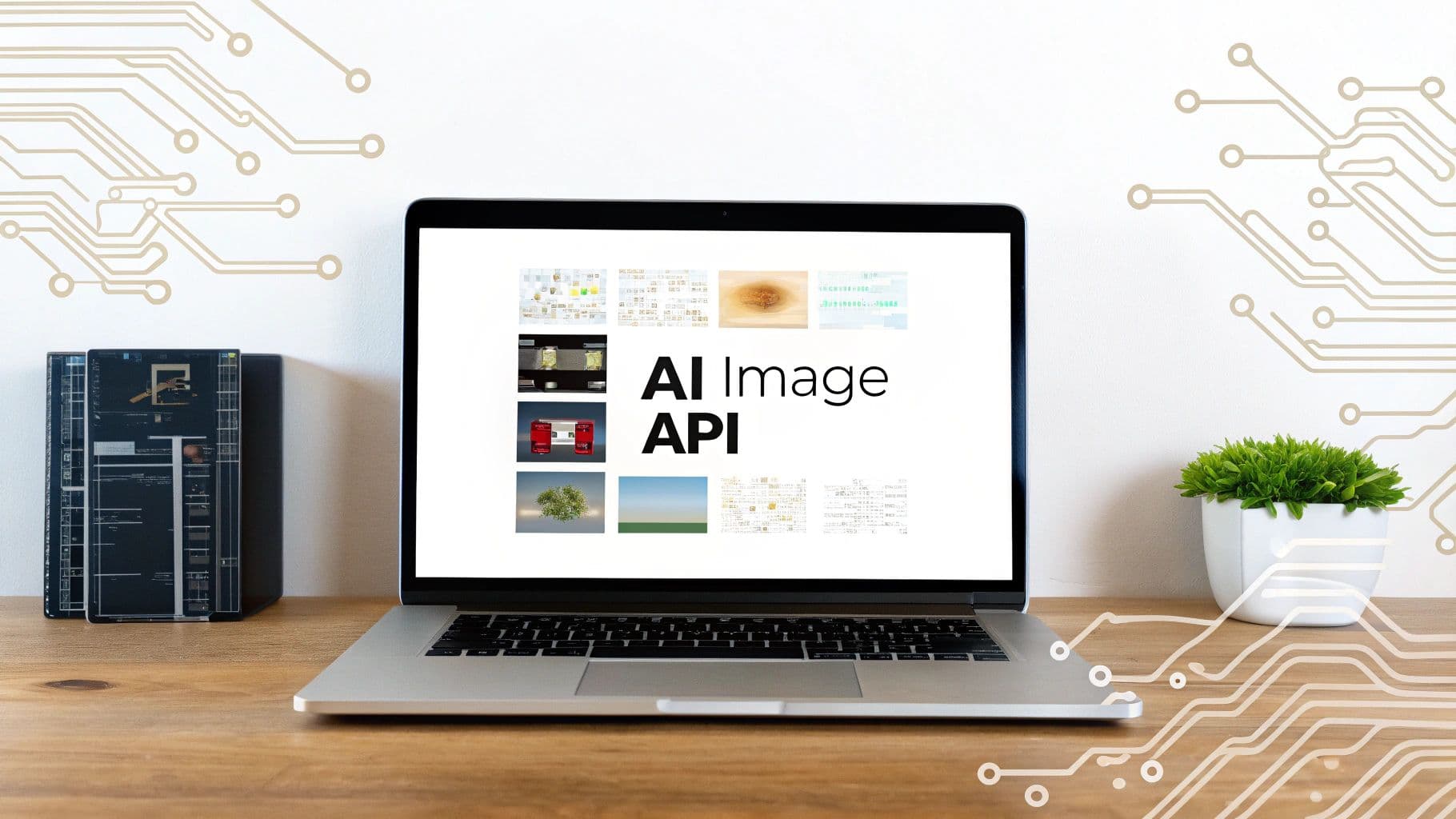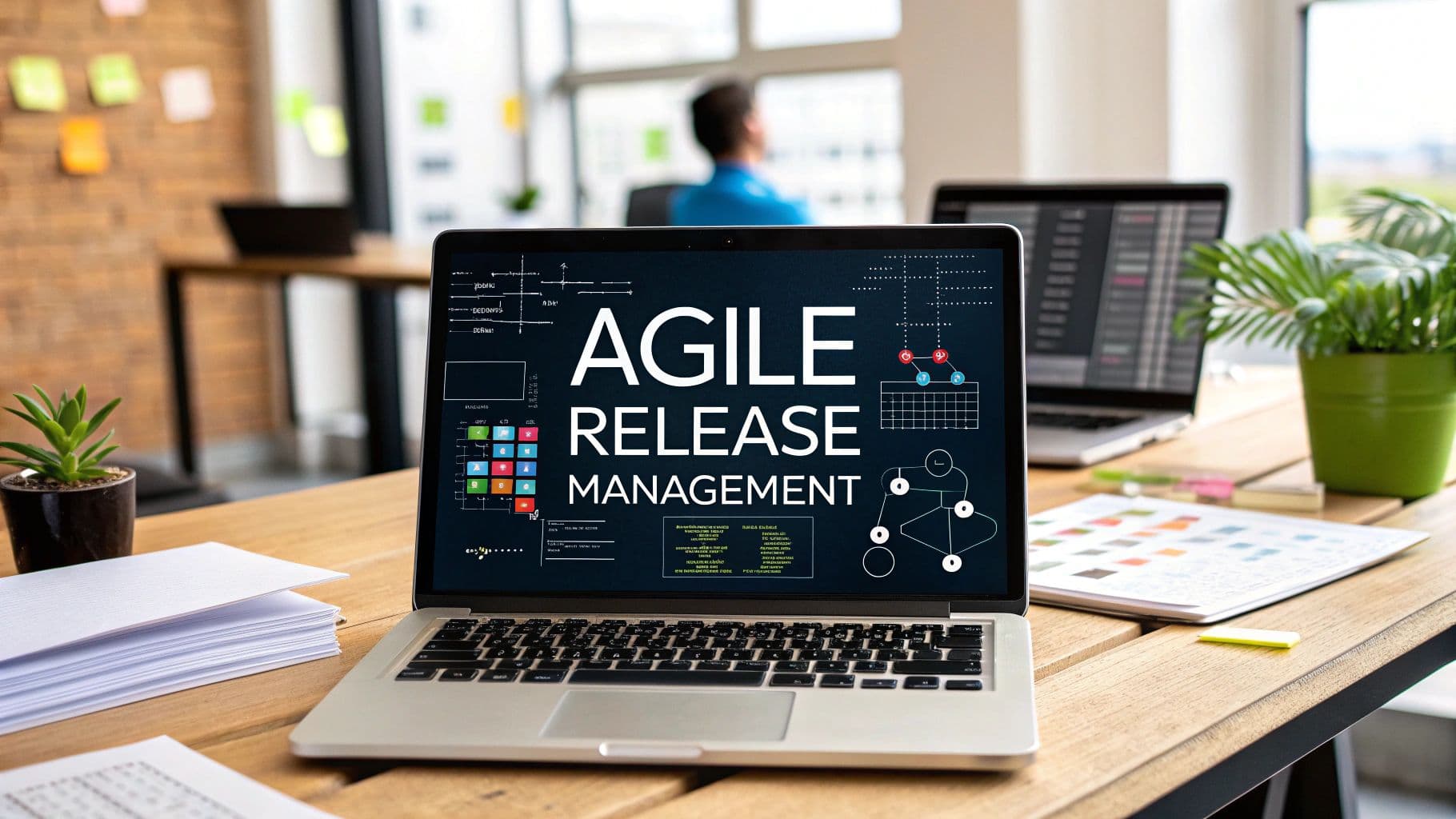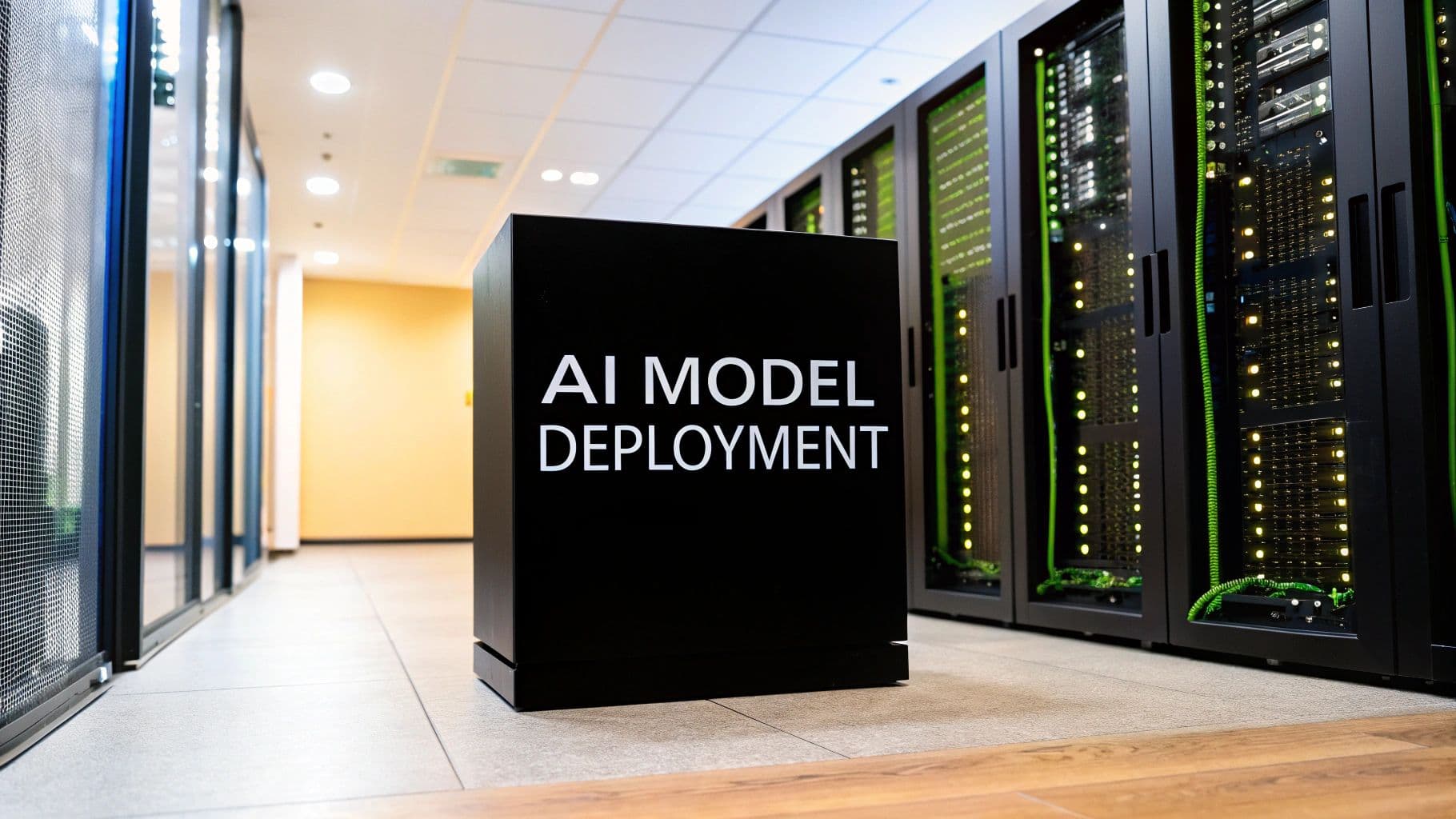image generation api
ai image generators
ai art
text to image
image api
Top Image Generation API in 2025 | Create Stunning Visuals
Generating Images with AI: A 2025 Overview
Need to quickly generate images for your project? This article presents the top 8 image generation APIs available in 2025. Discover the strengths, weaknesses, and pricing of each, including popular options like DALL-E 3, Stable Diffusion API, and Midjourney API. Whether you're building a startup, prototyping a new feature, or exploring AI as a hobby, this list will help you choose the right image generation API. AnotherWrapper, an AI starter kit, can fast-track your development by providing easy access to many of these powerful tools.
1. DALL-E 3 (OpenAI)
DALL-E 3, developed by OpenAI, stands as a leading contender in the realm of image generation APIs. It's renowned for producing highly realistic and artistic images from text descriptions, commonly referred to as prompts. A key differentiator is its seamless integration with ChatGPT, which assists users in refining their prompts to achieve outputs that align precisely with their vision. This powerful combination allows DALL-E 3 to handle complex scenes, diverse artistic styles, and intricately detailed compositions, resulting in high-resolution images. This makes it an invaluable tool for a range of users, from independent developers crafting unique visuals for their projects to marketing agencies seeking eye-catching graphics. Imagine effortlessly generating images of a "cyberpunk cat riding a unicorn through a neon-lit cityscape" – DALL-E 3 can bring that to life. It excels in understanding nuanced prompts, delivering stunning visuals that capture the essence of your creative ideas.
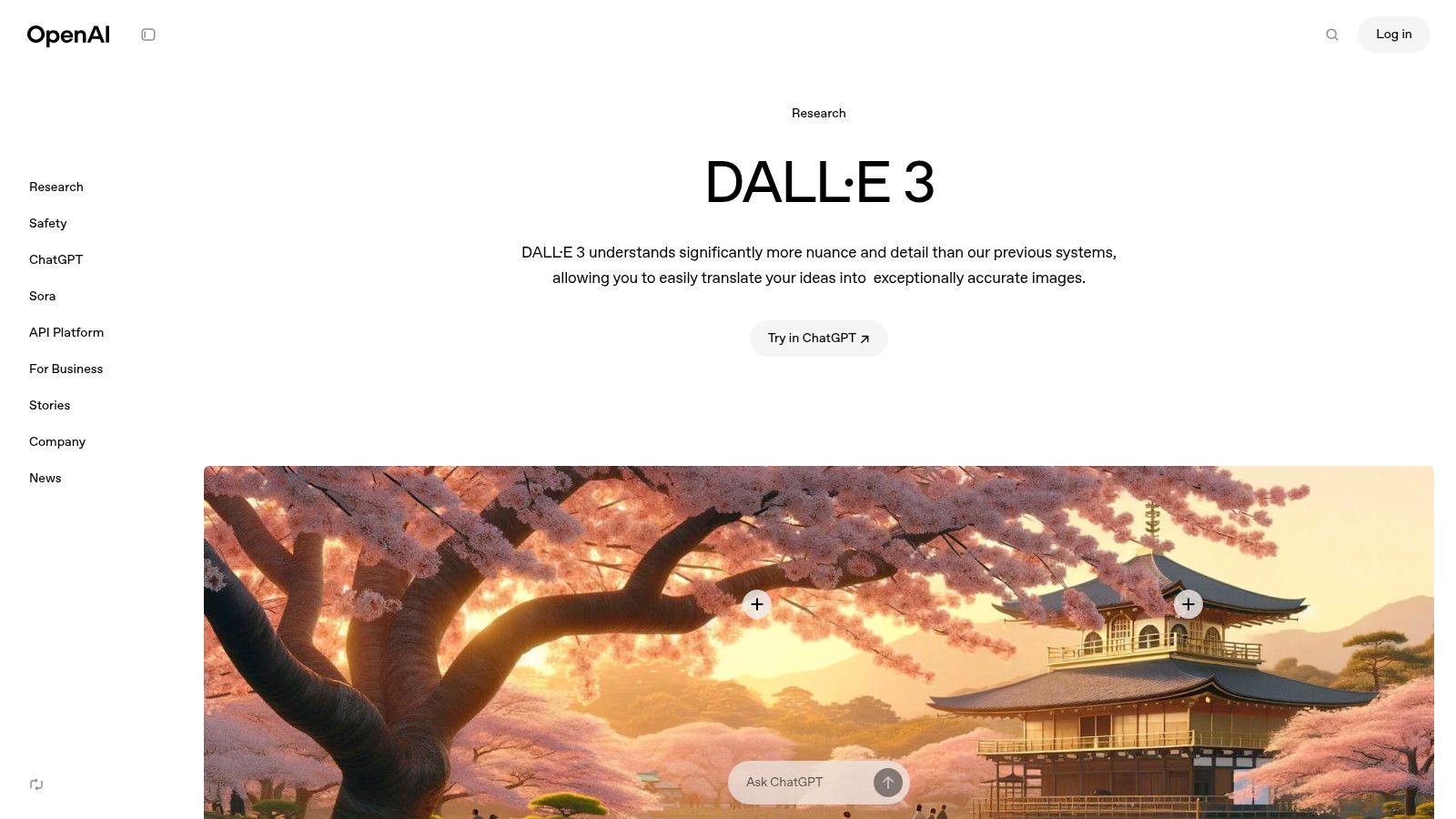
DALL-E 3's feature set makes it a compelling choice for various image generation api needs. Its output boasts a high resolution of 1024x1024 pixels (with other size options available), ensuring crisp and detailed visuals. Furthermore, the API demonstrates a refined understanding of spatial relationships and text rendering within images, minimizing inaccuracies and enhancing realism. The integration with ChatGPT drastically simplifies the prompt engineering process, a common hurdle for many image generation APIs. Content moderation is another core strength, employing robust filtering mechanisms to prevent the generation of inappropriate or harmful content. Finally, DALL-E 3 supports a wide spectrum of image styles and artistic interpretations, providing users with exceptional creative flexibility. Learn more about DALL-E 3 (OpenAI) for detailed insights and examples.
While DALL-E 3 offers a remarkable set of features, it's crucial to be aware of its limitations. Compared to some alternatives, it comes at a higher cost, which might be a consideration for budget-conscious users. Usage restrictions also apply to certain content types, aligning with OpenAI's commitment to responsible AI usage. Free tier users may encounter rate limiting, which can impact workflow depending on usage intensity. Finally, while DALL-E 3 excels at generating high-quality images from complex prompts, users seeking granular control over specific image elements might find specialized tools more suitable.
Key Features and Benefits:
- Highly Detailed Output: 1024x1024 resolution images and other size options.
- Enhanced Understanding: Accurate interpretation of spatial relationships and text rendering.
- ChatGPT Integration: Streamlined prompt refinement for optimal results.
- Content Moderation: Robust safety measures and content filtering.
- Diverse Styles: Support for various artistic interpretations and image styles.
Pros:
- Exceptional quality and photorealistic output.
- Strong understanding of complex prompts and concepts.
- Easy to use with clear documentation.
- Robust safety measures and content filtering.
Cons:
- Higher cost compared to some alternatives.
- Usage restrictions for certain content types.
- Rate limiting for free tier users.
- Less control over specific image elements compared to some specialized tools.
Website: https://openai.com/dall-e-3
2. Stable Diffusion API (Stability AI)
The Stable Diffusion API, offered by Stability AI, stands out as a powerful and versatile option in the landscape of image generation APIs. Leveraging the open-source Stable Diffusion model, this API grants developers programmatic access to cutting-edge text-to-image conversion and more. Its flexibility, community support, and potential for deployment on consumer hardware make it an attractive choice for a variety of users, from hobbyists to startups. This makes it a top contender for anyone seeking a powerful and adaptable image generation API.
What makes Stable Diffusion API a powerful tool?
This API opens doors to impressive image generation capabilities, going beyond simple text-to-image conversion. It provides access to various Stable Diffusion models, including the latest SDXL versions, known for generating high-quality and detailed images. Beyond text-to-image, the API supports image-to-image (modifying existing images based on text prompts) and inpainting (filling in missing parts of an image), expanding its creative potential. Control over image parameters like dimensions, steps, and guidance scale allows for fine-grained control over the generated output. The support for various sampling methods and fine-tuning options further empowers developers to optimize the generation process for their specific needs.
Practical Applications and Use Cases:
The Stable Diffusion API empowers a broad range of applications, including:
- Concept art and prototyping: Quickly generate visual representations of ideas for games, products, or marketing materials.
- Content creation: Produce unique and engaging visuals for blog posts, social media, and website content.
- E-commerce: Generate product images with different backgrounds or variations.
- AI-powered design tools: Integrate image generation into design software and workflows.
- Personalized content: Create custom avatars, wallpapers, or other visuals tailored to individual users.
Pricing and Technical Requirements:
Stability AI offers various pricing tiers for its API, often more affordable than closed-source alternatives. Check their website for the most up-to-date pricing information. For self-hosting, computational requirements can be significant, especially for larger models like SDXL. A robust GPU is generally recommended for efficient performance.
Implementation and Setup Tips:
While using the Stable Diffusion API requires some technical proficiency, numerous community resources and libraries can simplify the process. Familiarize yourself with the official documentation and explore community forums and repositories for helpful code examples and tutorials. Leveraging pre-built libraries can significantly reduce the initial setup effort.
Pros:
- More affordable pricing: Compared to closed-source alternatives, Stability AI often provides a more accessible pricing structure.
- Open-source foundation: Benefits from active community support, ongoing development, and a wealth of available resources.
- Greater flexibility and customization: Offers extensive control over image parameters and generation processes.
- Self-hosting option: Allows for enhanced privacy and potential cost savings for high-volume users.
Cons:
- Requires more technical knowledge: Achieving optimal results requires a deeper understanding of the underlying model and parameters.
- Quality can be less consistent: While improving, the quality of generated images can sometimes be less consistent than some premium alternatives.
- Higher computational requirements for self-hosting: Running locally demands significant processing power, especially for larger models.
- Documentation can be fragmented: Due to the rapidly evolving nature of the project, documentation can be spread across different sources.
Website: https://stability.ai/api
By offering a robust and flexible solution for image generation, the Stable Diffusion API empowers both seasoned developers and enthusiastic hobbyists to explore the potential of AI-driven visuals. Its open-source nature, combined with its powerful features and accessible pricing, positions it as a compelling choice in the image generation API landscape.
3. Midjourney API
Midjourney, while not offering a traditional RESTful image generation API, provides API-like functionality through a clever integration with the Discord platform. This approach distinguishes it from other image generation APIs and caters to a specific user base. It’s known for producing highly artistic and stylized images, making it a popular choice for those seeking a distinct aesthetic quality and visually striking compositions. Instead of using traditional API calls, users interact with the Midjourney bot within Discord using text prompts and command-line style parameters. This method, although unconventional, facilitates a unique workflow for generating creative visuals. This approach offers distinct advantages for certain users, especially those already familiar with the Discord ecosystem, by enabling a streamlined creative process directly within a communication hub. It allows for seamless sharing and collaboration on image generation projects within existing Discord servers.
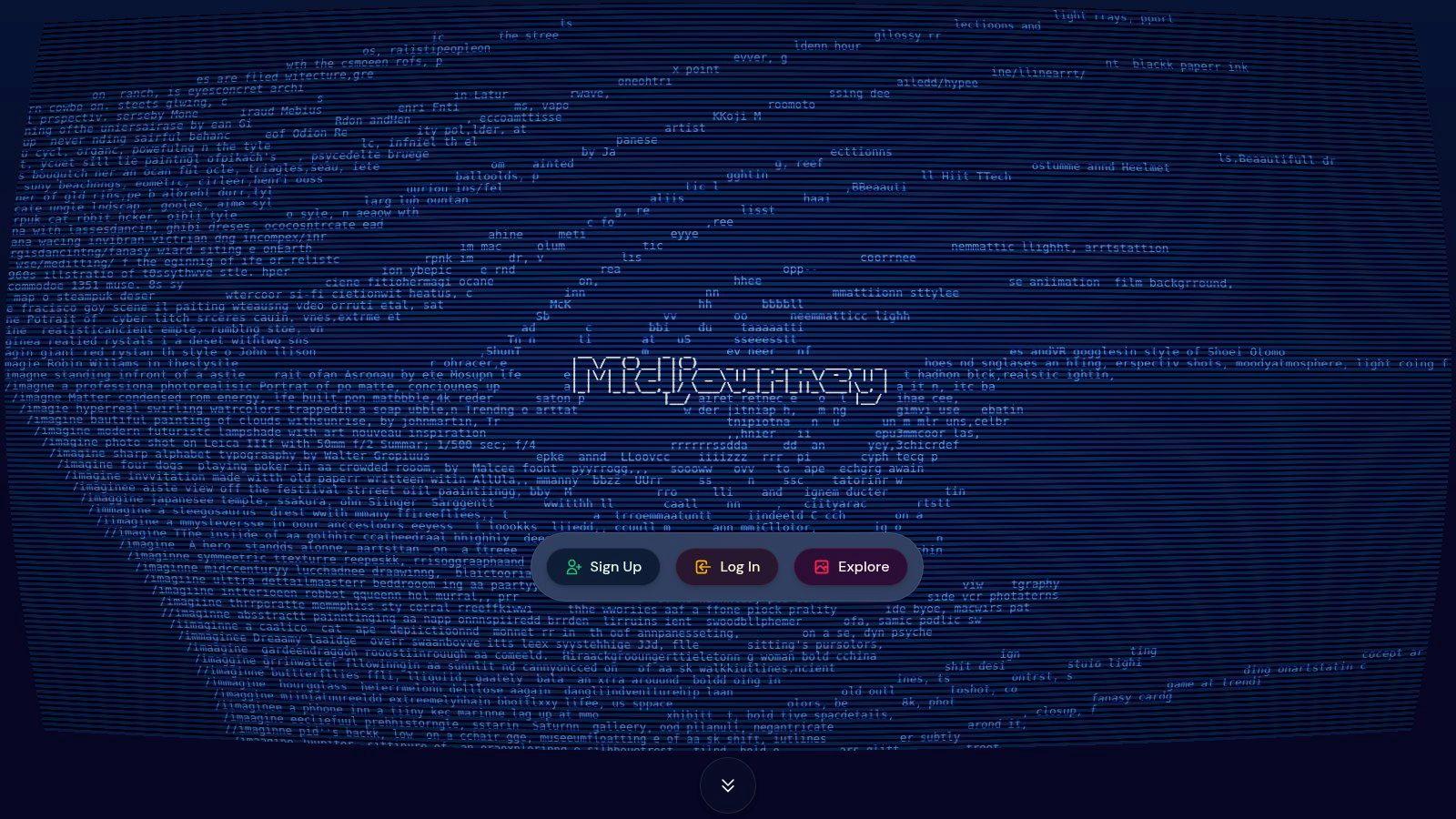
Midjourney’s strength lies in its artistic prowess. The platform excels at creating images with excellent composition and lighting, offering multiple version options (V5, V6) each with unique aesthetic characteristics. For users seeking fine-grained control, Midjourney provides advanced parameter controls including aspect ratio, stylization, and variation settings. Further refining the creative process, you can upscale existing images and generate variations, iterating upon initial outputs to achieve desired results. This focus on art and aesthetics makes Midjourney a powerful tool for anyone looking to create visually compelling imagery, from independent artists and designers to marketing agencies seeking eye-catching visuals.
For developers and tech-savvy users, the lack of a traditional RESTful API might present an integration hurdle. While the Discord interface simplifies the image creation process for beginners, it might limit the flexibility required for complex workflows or automated tasks within larger applications. Services like DALL-E 2 and Stability AI’s APIs offer more direct programmatic control, which may be preferable for certain integration scenarios. Midjourney’s pricing model, which is subscription-based with tiered access levels, can also be a factor, especially for high-volume commercial use. Finally, queue times can vary based on server load, a potential drawback compared to dedicated API solutions.
Despite the unconventional approach, Midjourney's unique features secure its place on this list. The ease of use through Discord, combined with the distinct artistic style, makes it a valuable tool for a broad range of users, from hobbyists experimenting with AI art to professionals seeking distinctive visuals. Its strong community fosters the sharing of techniques and prompt engineering tips, further enhancing the platform's accessibility and creative potential. For those prioritizing artistic flair and ease of use through a familiar platform, Midjourney offers a compelling alternative to traditional image generation APIs. You can explore the platform and its pricing options at https://www.midjourney.com/. Setting up is as simple as joining their Discord server and subscribing to a plan.
4. Deepai.org Image Generation API
The Deepai.org Image Generation API offers a readily accessible pathway for developers to integrate AI image creation into their projects. Its straightforward REST API facilitates easy implementation, making it particularly appealing to those new to image generation APIs. Beyond text-to-image conversion, DeepAI provides a versatile toolkit of AI-powered image manipulation functionalities, including style transfer, colorization, and super-resolution, broadening its applicability beyond basic image generation. This makes it a useful resource for a range of image processing tasks, allowing developers to experiment with different techniques and achieve diverse visual effects. This accessibility, combined with a generous free tier and reasonable pricing, makes DeepAI a strong contender for smaller projects and startups looking to explore the potential of AI-generated imagery. Learn more about Deepai.org Image Generation API
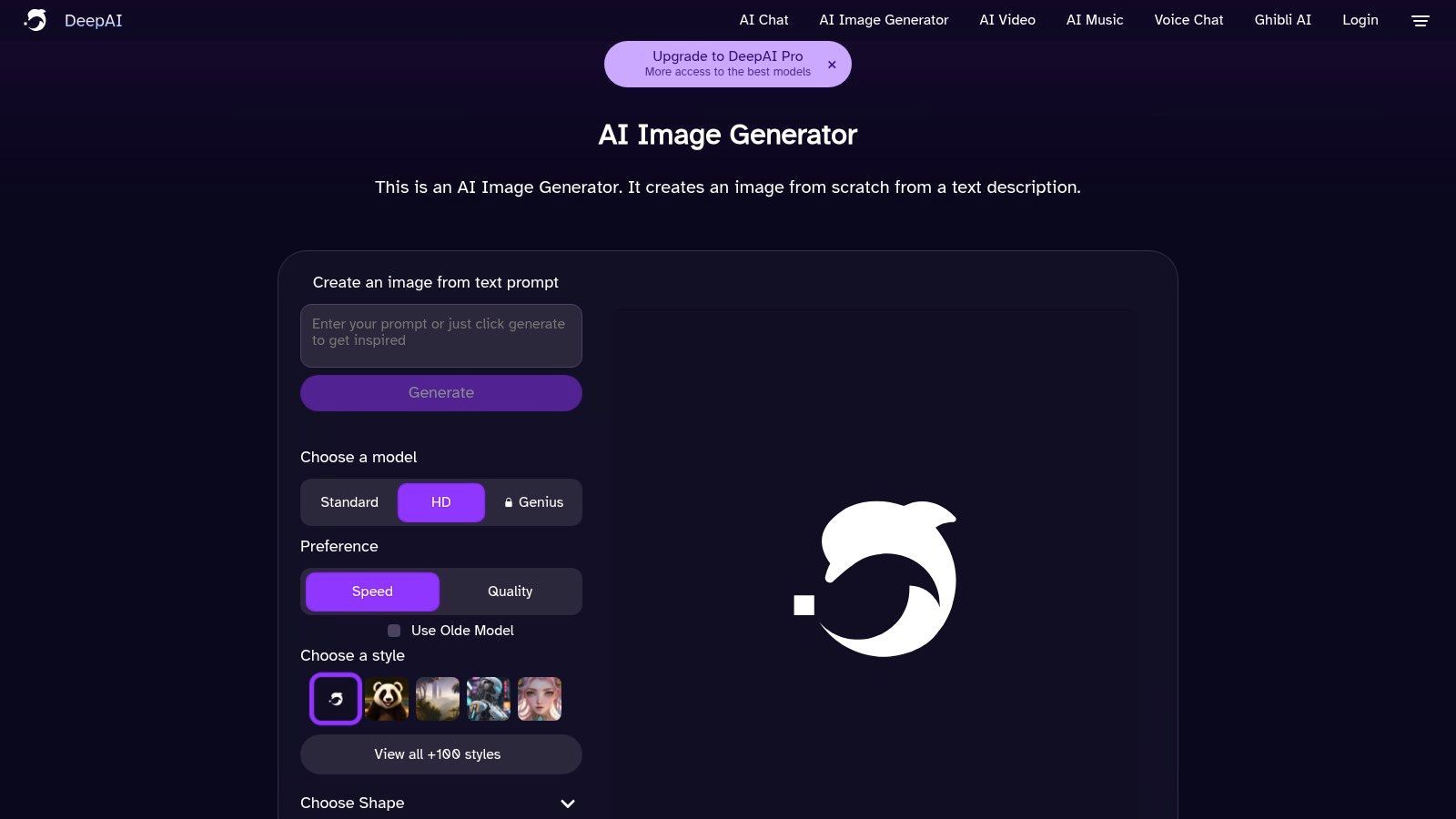
DeepAI’s ease of use is a key advantage. Its simple REST API architecture simplifies the integration process, reducing the technical hurdles for developers. Available SDKs for various programming languages further streamline the implementation process, allowing developers to work within their preferred environments. This ease of integration makes it ideal for independent developers, hobbyists, and startups looking for a quick and easy way to incorporate image generation into their applications without extensive coding.
While DeepAI provides a convenient and cost-effective solution for exploring AI image generation, it's important to acknowledge its limitations. The image quality, while suitable for certain applications, generally falls short of the results achievable with premium, specialized alternatives like Midjourney or Stability AI. It offers fewer customization options and parameters, restricting the level of control over the generated output. The variety of styles achievable is also more limited compared to solutions specifically designed for artistic image generation. This makes DeepAI less suitable for production-grade applications demanding cutting-edge visuals or highly specific stylistic outputs.
For instance, if you're a freelance designer creating mockups for a website, DeepAI can quickly generate placeholder images to populate your designs. Or, if you're a product manager prototyping a new app feature that involves user-generated visuals, DeepAI can provide a cost-effective way to test the concept. However, if you're developing a high-end advertising campaign or a digital art platform, you might find the limitations in image quality and stylistic range to be a significant drawback.
DeepAI shines in its simplicity and versatility. While not a replacement for more advanced image generation APIs, it provides an accessible entry point for developers seeking to explore the capabilities of AI image processing. Its straightforward integration, diverse toolkit, and affordable pricing make it a valuable resource for experimentation, prototyping, and smaller-scale projects where the highest level of image quality isn't the primary concern. You can find more details and get started on their website: https://deepai.org/machine-learning-model/text2img.
5. Replicate API
Replicate offers a unique approach to image generation APIs. Instead of building and maintaining your own complex infrastructure for running machine learning models, Replicate provides a cloud-based platform that simplifies the process dramatically. This makes it particularly attractive for developers and businesses who want to leverage the power of image generation without the overhead of managing GPUs and other resources. It's a powerful tool in the image generation API landscape, offering access to a diverse range of models through a single, unified interface. This allows you to experiment with various algorithms, from Stable Diffusion variations and DALL-E to more niche generators, all without switching APIs or managing separate accounts. This flexibility lets you find the perfect model for your specific needs, whether it's generating photorealistic images, artistic renderings, or something entirely unique.
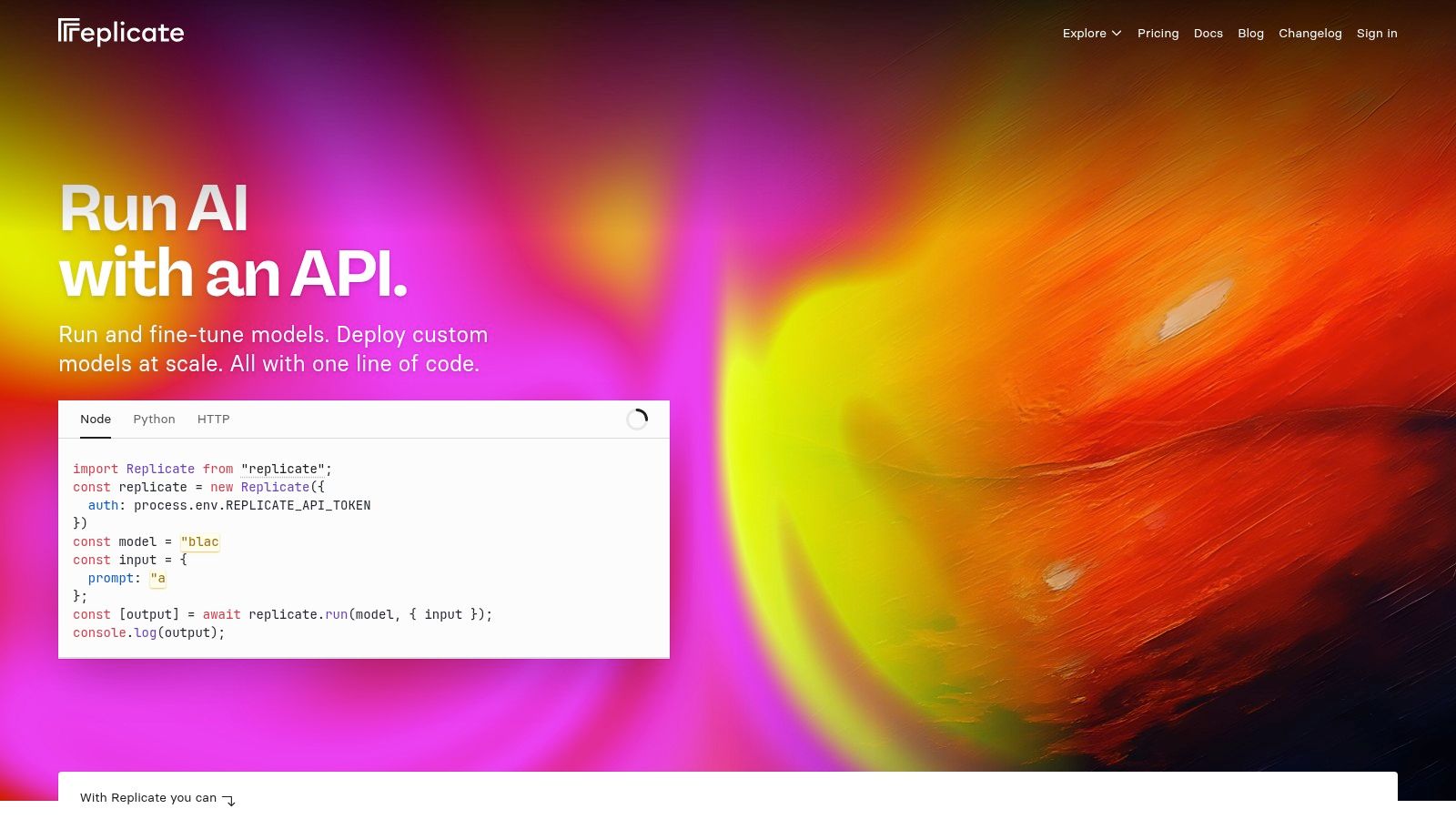
For developers, Replicate offers both a web UI and a robust API, catering to both quick experimentation and integration into larger applications. The API is well-documented, making it straightforward to integrate into your projects. You can fine-tune the image generation process by adjusting model parameters and settings, enabling granular control over the output. Furthermore, Replicate's model versioning system ensures consistent results, even as models are updated and improved. This is crucial for production environments where reproducibility and stability are paramount. For example, a startup building a graphic design tool could leverage the Replicate API to offer users a diverse range of image generation styles without needing to manage the underlying infrastructure themselves. Similarly, freelance artists could integrate the API into their workflow to rapidly generate variations of creative concepts.
Replicate's pay-per-computation pricing model can be very advantageous for those starting out or with sporadic usage, only paying for the processing power they consume. However, high-volume usage can become expensive, so it’s important to monitor your usage and potentially explore other solutions for large-scale deployments. While the variety of available models is a significant advantage, the quality of results varies between them, and some of the more advanced models have significantly higher computational costs. Finally, model availability is subject to the creator's terms, so access might change.
Replicate deserves its place on this list because it democratizes access to sophisticated image generation models. Its ease of use, combined with the breadth of available models and the flexibility of its API, makes it a compelling choice for a wide range of users, from hobbyists experimenting with AI to businesses integrating image generation into their products. If you're looking for a versatile image generation API that lets you explore a wide range of models without the hassle of managing infrastructure, Replicate is definitely worth considering. You can explore their offerings further on their website: https://replicate.com/.
6. Runway Gen-2
Runway Gen-2 stands out in the crowded field of image generation APIs due to its unique focus on video. While other APIs primarily concentrate on static images, Runway Gen-2 leverages the power of AI to generate and edit both images and videos from text prompts, opening up a new realm of possibilities for creative professionals and developers. It also offers powerful image-to-video functionality, allowing users to transform static imagery into dynamic moving visuals. This makes it an invaluable tool for a variety of applications, from motion graphics and filmmaking to video production workflows and interactive experiences. If your project demands moving visuals generated or manipulated by AI, Runway Gen-2 is a compelling option.
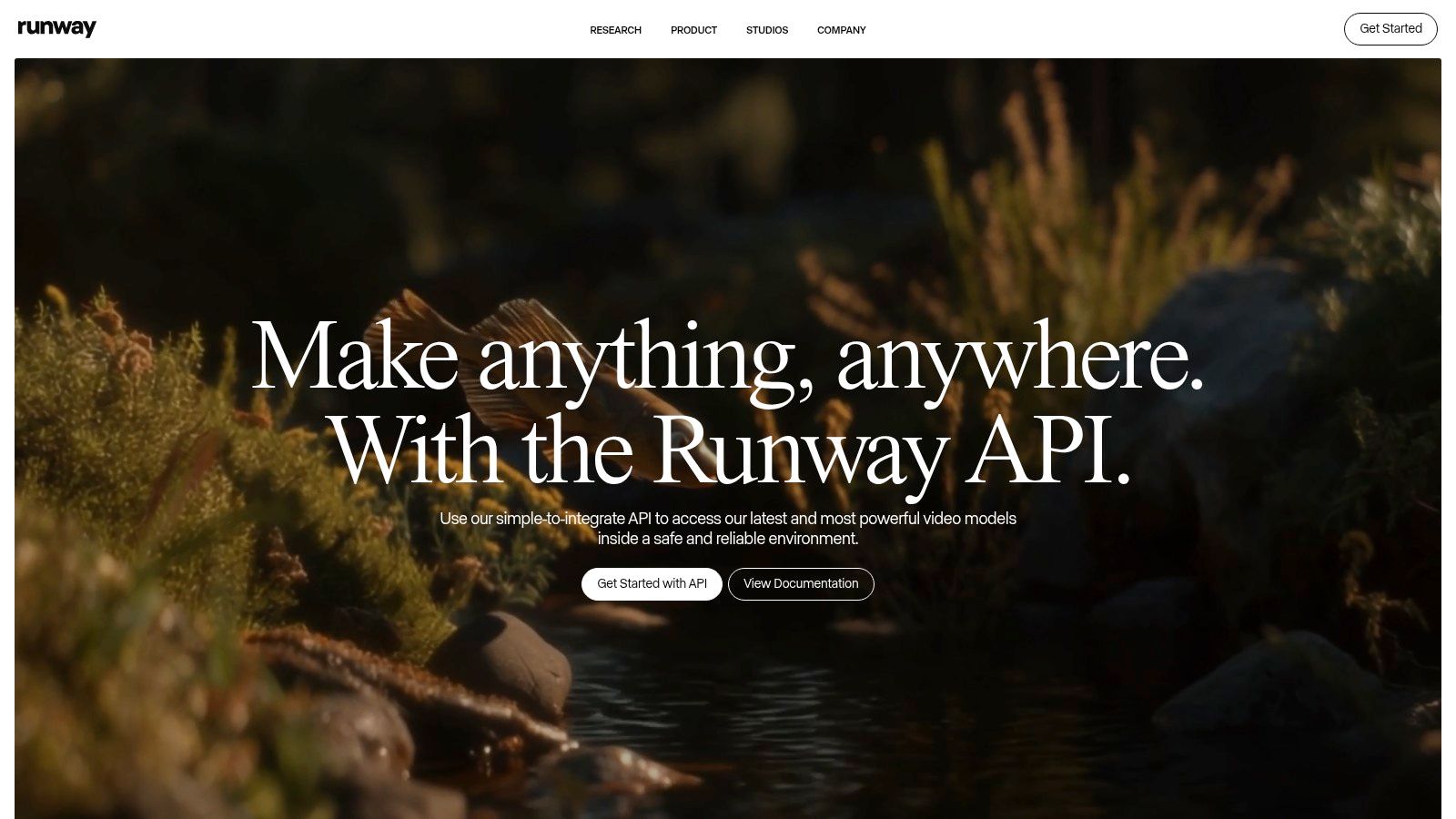
For independent developers and hobbyists experimenting with AI-generated video content, Runway Gen-2 offers a powerful platform to bring their ideas to life. Startup founders and entrepreneurs can leverage this image generation API to create innovative marketing materials, product demos, and engaging social media content. Freelance agencies and consultants can use Gen-2 to enhance their client offerings with cutting-edge video production capabilities. Product managers and technical leads exploring new product features can prototype and test video-based functionalities with ease. Even AI enthusiasts and prototypers can use this sophisticated tool to push the boundaries of generative AI.
Specific features such as text-to-video, image-to-video, customizable video motion, and content-aware editing tools, provide a granular level of control over the generated output. Its high-quality output makes it suitable for professional work, particularly within the media and entertainment industry. Runway also demonstrates a commitment to innovation through regular feature updates and improvements, ensuring that users have access to the latest advancements in AI-powered video generation.
While pricing details are not publicly available on the website and require contacting Runway directly, it's worth noting that its advanced capabilities generally come with a higher price point than standard image-only generators. Developers should also be prepared for a more complex implementation compared to simpler APIs, and while the video generation is impressive, it still has limitations regarding length and complexity. There is a learning curve associated with achieving optimal results, so setting aside time for experimentation is essential.
Runway Gen-2’s focus on video makes it a truly unique offering in the image generation API landscape. While other tools offer static image generation, Gen-2’s ability to create and manipulate video content sets it apart. If you're looking for an image generation API that extends into the realm of video, Runway Gen-2 is definitely worth exploring. You can find more information and request API access on their website: https://runwayml.com/api/
7. Hugging Face Inference API
The Hugging Face Inference API stands out as a powerful image generation API, offering access to a vast repository of pre-trained models. This makes it an invaluable tool for anyone looking to explore the diverse landscape of image generation, from Stable Diffusion variations and DALL-E mini to numerous community-created models. Its open platform and unified API interface simplify the process of experimenting with different architectures and finding the ideal model for specific needs, whether it's generating photorealistic images, stylized artwork, or even anime-inspired visuals. This versatility makes it a top contender in the field of image generation APIs.
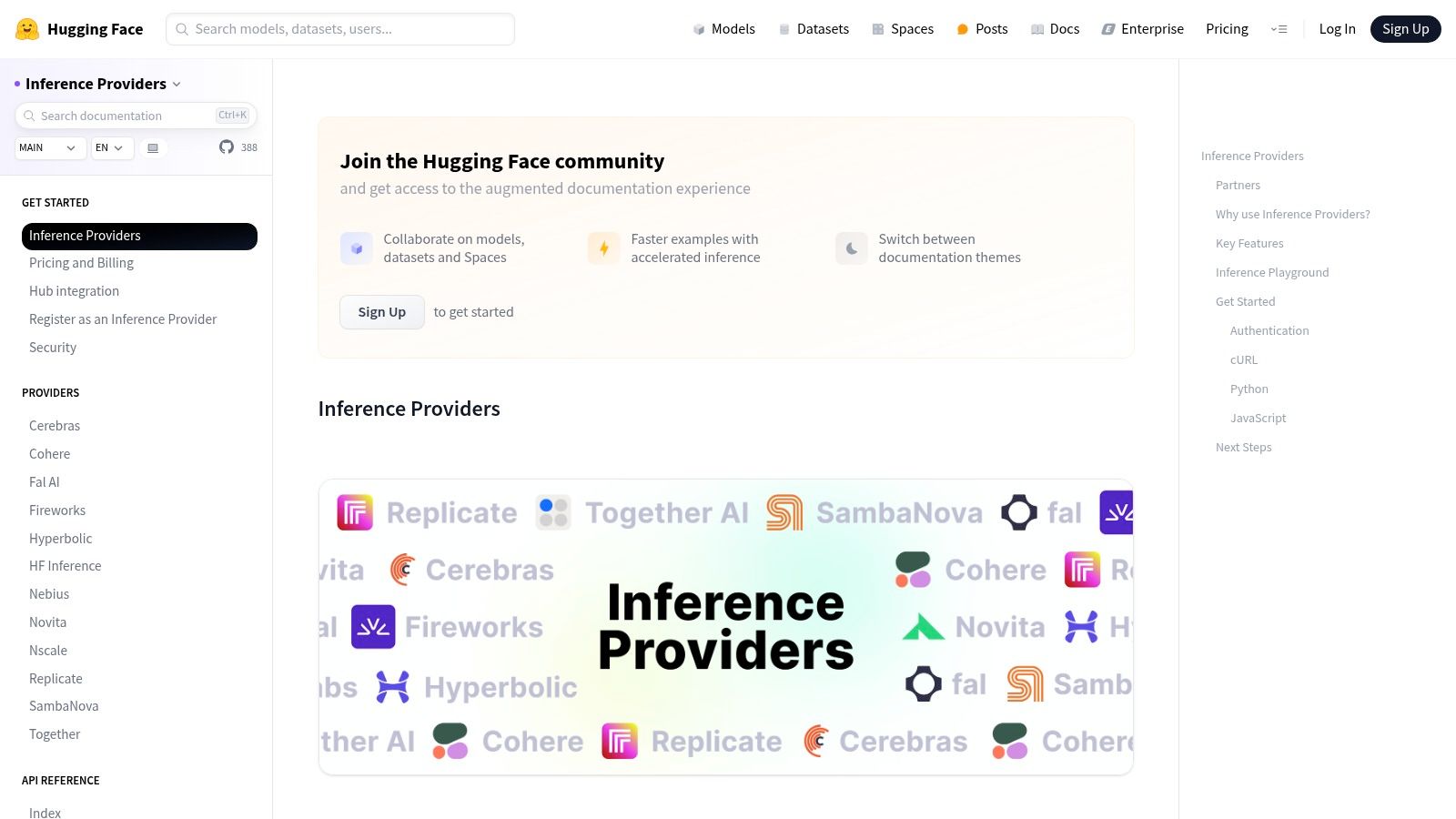
Imagine needing to generate images for a variety of projects: product mockups one day, cartoon characters for a children's book the next, and photorealistic landscapes for a travel blog later that week. Instead of juggling different APIs and SDKs, the Hugging Face Inference API allows you to access all these capabilities through a single point of contact. Its customizable inference parameters offer fine-grained control over the generated output, while the availability of specialized models ensures you can find the perfect style for every project. For independent developers, startup founders, and freelance agencies, this translates to significant time and resource savings.
For product managers and technical leads exploring the potential of AI-powered image generation in their applications, the Hugging Face Inference API provides an excellent sandbox for experimentation. The free tier allows for testing and low-volume applications, while the comprehensive documentation and strong community support make it easy to get started. Even AI enthusiasts and prototypers can benefit from the vast selection of models and the ability to deploy their own fine-tuned models, fostering innovation and pushing the boundaries of image generation.
While the breadth of options is a strength, it can also be a challenge. The quality and performance can vary significantly between models, requiring some experimentation to find the optimal choice for a given task. Compared to single-model focused services, the Hugging Face Inference API may require more upfront effort in model selection and parameter tuning. However, this flexibility ultimately empowers users with a much broader range of creative possibilities. Pricing for the Hugging Face Inference API is consumption-based, with a generous free tier available. Details on pricing tiers and usage quotas can be found on the Hugging Face website. Technical requirements are minimal, primarily revolving around making HTTP requests to the API endpoints. Several client libraries are available in various programming languages, further simplifying the integration process.
To get started, visit the Hugging Face website, browse the available models, and follow the provided documentation for API usage and authentication. The Hugging Face community is also an invaluable resource for tips, tutorials, and support.
8. Cloudinary AI Image Generator
Cloudinary's AI Image Generator offers a compelling solution for those seeking an image generation API integrated seamlessly with a robust media management platform. While other specialized services might boast slightly more cutting-edge image generation quality, Cloudinary shines in its end-to-end approach. This makes it a powerful tool, particularly for users already leveraging Cloudinary's ecosystem or those who need more than just basic image generation. If your workflow requires storage, transformation, optimization, and delivery, all within a secure and scalable environment, then Cloudinary’s AI Image Generator deserves a closer look.
Learn more about Cloudinary AI Image Generator
This tool allows developers to generate images from text prompts and directly integrate them into their existing Cloudinary media workflows. This tight integration eliminates the need to juggle multiple services for different stages of image handling. Imagine generating product mockups, social media visuals, or even dynamic website banners, all while automatically optimizing and delivering them via Cloudinary's global CDN. This streamlines the process considerably, especially for businesses with high-volume image needs.
Features and Benefits:
- Text-to-image generation integrated with media management: Generate images and manage them within a unified platform, simplifying workflows.
- Image optimization and transformation capabilities: Resize, crop, apply effects, and optimize generated images using Cloudinary's extensive toolkit.
- Global CDN for fast delivery: Ensure generated images are delivered quickly and efficiently to users worldwide.
- Comprehensive asset management tools: Organize, tag, and manage your generated images alongside other media assets.
- API SDKs for multiple programming languages: Integrate the image generation API seamlessly into your applications.
Use Cases:
- E-commerce: Generating product images with different backgrounds or showcasing variations.
- Marketing & Advertising: Creating engaging visuals for social media campaigns or website banners.
- Content Creation: Generating unique images for blog posts, articles, or other digital content.
- Prototyping and Design: Quickly creating mockups and visual assets for early-stage product development.
Pros:
- End-to-end solution: Handles everything from image generation to delivery.
- Powerful image manipulation tools: Offers more than just generation, allowing for extensive post-processing and optimization.
- Scalable infrastructure: Built for high-traffic applications and large-scale image generation.
- Enterprise-grade security and compliance: Provides peace of mind regarding data security and regulatory compliance.
Cons:
- Image generation quality: While continually improving, the generated images might not be as refined or stylistically diverse as those from highly specialized image generation APIs.
- Cost: Can become expensive at scale due to Cloudinary's broader pricing model.
- Complexity: Setting up might be more involved than simpler generation-only tools if you're not already using Cloudinary.
- Customization: Limited control over the underlying generative models.
Pricing and Technical Requirements:
Cloudinary offers a tiered pricing structure based on usage, including storage, transformations, and bandwidth. Specific pricing for the AI Image Generator can be found on their website. Technical requirements involve integrating with the Cloudinary platform via their API and SDKs, available for various programming languages like Python, Java, PHP, Node.js, and more.
Comparison with Similar Tools:
Compared to dedicated image generation APIs like DALL-E 2 or Midjourney, Cloudinary prioritizes integration with its media management platform. This makes it less suited for purely experimental image generation and more geared towards practical application and deployment within existing workflows. If your needs extend beyond generation and encompass a wider range of media management tasks, Cloudinary offers a distinct advantage.
Implementation Tips:
- Familiarize yourself with Cloudinary's documentation and API references.
- Leverage existing Cloudinary integrations if you already use their platform.
- Explore the various image transformation options available to optimize generated images.
- Carefully consider your usage patterns and choose an appropriate pricing tier.
Cloudinary AI Image Generator stands out as a valuable image generation API option for those seeking a comprehensive solution integrating generation with robust media management. Its strengths lie in its end-to-end workflow, powerful image manipulation tools, and scalable infrastructure, making it a compelling choice for businesses and developers who need more than just basic image creation. Visit the Cloudinary website for more information.
Image Generation APIs Feature Comparison
| AI Image Generator | Core Features/Characteristics | User Experience/Quality ★ | Value Proposition 💰 | Target Audience 👥 | Unique Selling Points ✨ |
|---|---|---|---|---|---|
| DALL-E 3 (OpenAI) | High-res photorealistic images, prompt refinement, safety | ★★★★☆ Exceptional quality | 💰 Higher cost, enterprise-grade | 👥 Developers, enterprises | 🏆 Integrated with ChatGPT, robust safety |
| Stable Diffusion API | Open-source, multi-models, customizable, self-host option | ★★★★ Consistent but variable | 💰 Affordable, flexible | 👥 Tech-savvy devs, hobbyists | ✨ Self-hosting, open-source foundation |
| Midjourney API | Discord-based, stylized artistic images, advanced params | ★★★★ Artistic excellence | 💰 Higher price, subscription | 👥 Artists, creative professionals | 🏆 Distinctive aesthetic, strong community |
| Deepai.org Image Generation API | Simple REST API, multiple image tools, generous free tier | ★★★ Moderate quality | 💰 Budget-friendly | 👥 Startups, small projects | ✨ Versatile image processing tools |
| Replicate API | Multi-model access, customizable params, pay-per-use | ★★★★ Quality varies by model | 💰 Pay-as-you-go, no infra needed | 👥 Developers experimenting | ✨ Access to many models via one API |
| Runway Gen-2 | Text-to-video & image generation, content-aware editing | ★★★★ High quality, video focus | 💰 Premium pricing | 👥 Media, film, creatives | 🏆 Video generation, pro creative workflows |
| Hugging Face Inference API | Thousands of open-source models, customizable params | ★★★ Variable by model | 💰 Free tier, pay for scale | 👥 Researchers, experimenters | ✨ Massive model selection, deploy own models |
| Cloudinary AI Image Generator | Text-to-image + media management, global CDN, optimization | ★★★★ Reliable infrastructure | 💰 Enterprise cost | 👥 Businesses managing media assets | 🏆 End-to-end image generation & delivery |
Choosing the Right Image Generation API
Selecting the best image generation API from the options discussed—DALL-E 3, Stable Diffusion API, Midjourney API, Deepai.org Image Generation API, Replicate API, Runway Gen-2, Hugging Face Inference API, and Cloudinary AI Image Generator—requires careful consideration of several factors. Your project's specific needs, your technical comfort level, and your budget will significantly influence your decision. Prioritize image quality, ease of use, cost, and available features when evaluating each image generation API. If your focus is more niche, say, for example, creating memes, consider dedicated meme generation platforms like SuperMeme.ai that offer a wide range of templates and customization options. This top 8 list offers a comprehensive overview of leading image generation APIs in 2025, empowering you to confidently navigate the exciting world of AI-powered image creation.
The most important takeaway is that experimentation is key. Each image generation API offers unique strengths and weaknesses. Testing different APIs with your specific use case will provide the most valuable insights. Consider starting with APIs that offer free tiers or generous trial periods to minimize initial investment. Also, pay close attention to the documentation and community support available for each API, as these resources can be invaluable during the integration process.
The landscape of image generation APIs is constantly evolving, with new players and features emerging regularly. Staying informed about the latest advancements will ensure you're leveraging the most powerful and efficient tools available. The future of visual content creation is here, and with the right image generation API, you can unlock unprecedented creative potential.
Ready to simplify your integration with these powerful APIs and accelerate your development process? AnotherWrapper streamlines access to multiple image generation APIs, allowing you to quickly experiment and launch your AI-powered image projects. Explore AnotherWrapper today and unlock the full potential of AI image generation.
Fekri

